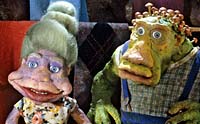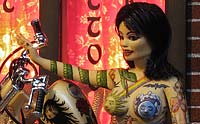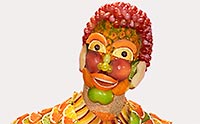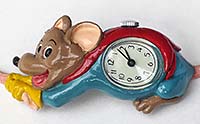The Living Body as Sculpture
Some may consider bodybuilding a sport but it can also be considered a true art form. Bodybuilders literally sculpt themselves by making conscious decisions about where to add and where to subtract, accomplishing their goal with focused weight training, exercise, and diet. The objective of their efforts is to reach the physical ideal, which is certainly subjective depending on the eye of the beholder.
When I was a very young man, I attended the 1979 Mr. Olympia competition and filmed many of the highlights with my trusty Super 8 camera. In that event, the bodybuilders essentially gave stage performances as living, breathing sculptures. Frank Zane, who is considered by many to be the greatest bodybuilder of all time, won the contest for a third consecutive year. A unique guest poser was also at the event, pioneering female bodybuilder Lisa Lyon. This show represented the end of an era, as within a few short years, the world of professional bodybuilding underwent significant changes. The following is some background information on the featured stars in my movie clip.
Frank Zane was known for his ideal balance of proportion, symmetry, and muscle definition. His posing routines were charismatic and majestic. In competitions, Zane's aesthetic look enabled him to routinely beat other competitors who had far more muscle mass. During his professional bodybuilding career, Zane also worked as a mathematics and chemistry teacher. He wrote at least nine books, some in collaboration with his wife Christine, on fitness and nutrition. Currently, at the age of 70, Zane maintains his fitness through weight training, and he offers one-on-one coaching in San Diego.
Lisa Lyon won the very first IFBB Women's World Pro Bodybuilding Championship, also held in 1979. Like Zane, she advocated for the artistic side of bodybuilding and wrote a popular fitness book, Lisa Lyon's Body Magic. Additionally, Lyon had a modeling career, and was featured in Lady Lisa Lyon by photographer Robert Mapplethorpe, and she made an appearance in Playboy magazine. After a brief acting career in the 1980s, she disappeared from the public eye.
Bodybuilding could be a form of art, but that aspect has become more questionable in recent years. Since the 1970s, there has been an obsession with massive muscle size at the expense of aesthetics in the pro competitions. The use of steroids and growth hormones has enabled both men and women to have "monster" physiques, a state that would have been impossible in the past. Amazingly, a physique like Frank Zane's would be considered too thin to win a professional title like Mr. Olympia anymore! What once originated from ideals of health, fitness, and self-improvement has devolved into contests that resemble freak shows. Nevertheless, many bodybuilders still strive for the aesthetic look of natural proportion and symmetry, instead of the out-of-control pursuit of massive size, particularly at the professional level.
Here are some nerdy notes about the movie itself. I shot a lot of film of the 1979 Mr. Olympia as well as the 1979 IFBB World Amateur Championships, which were held on the same weekend. In all, I captured about 40 minutes of the best bodybuilders in the world at that time. The film sat in storage until 2006 when I made a digital frame-by-frame conversion; however, the movie had issues. Being shot on high-speed Ektachrome 160 film in the tiny Super 8 format, the image was grainy and the color had shifted to magenta with age. Furthermore, I shot the film fairly far from the stage, hand-held and zoomed in, which resulted in camera shake. With computer software and a lot of careful tweaking I was able to fix those issues. Now the movie almost looks like it was shot on a tripod! For those interested in seeing the rest of my historic film footage, it was included in the anthology Mr. Olympia The Golden Years from GMV Bodybuilding.







































